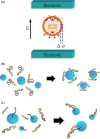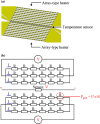Sample pretreatment and nucleic acid-based detection for fast diagnosis utilizing microfluidic systems
- PMID: 22146901
- PMCID: PMC7088154
- DOI: 10.1007/s10439-011-0473-4
Sample pretreatment and nucleic acid-based detection for fast diagnosis utilizing microfluidic systems
Abstract
Recently, micro-electro-mechanical-systems (MEMS) technology and micromachining techniques have enabled miniaturization of biomedical devices and systems. Not only do these techniques facilitate the development of miniaturized instrumentation for biomedical analysis, but they also open a new era for integration of microdevices for performing accurate and sensitive diagnostic assays. A so-called "micro-total-analysis-system", which integrates sample pretreatment, transport, reaction, and detection on a small chip in an automatic format, can be realized by combining functional microfluidic components manufactured by specific MEMS technologies. Among the promising applications using microfluidic technologies, nucleic acid-based detection has shown considerable potential recently. For instance, micro-polymerase chain reaction chips for rapid DNA amplification have attracted considerable interest. In addition, microfluidic devices for rapid sample pretreatment prior to nucleic acid-based detection have also achieved significant progress in the recent years. In this review paper, microfluidic systems for sample preparation, nucleic acid amplification and detection for fast diagnosis will be reviewed. These microfluidic devices and systems have several advantages over their large-scale counterparts, including lower sample/reagent consumption, lower power consumption, compact size, faster analysis, and lower per unit cost. The development of these microfluidic devices and systems may provide a revolutionary platform technology for fast sample pretreatment and accurate, sensitive diagnosis.
Figures




Similar articles
-
Miniaturization of molecular biological techniques for gene assay.Analyst. 2010 Jul;135(7):1499-518. doi: 10.1039/c000037j. Epub 2010 Apr 14. Analyst. 2010. PMID: 20390199 Review.
-
PCR microfluidic devices for DNA amplification.Biotechnol Adv. 2006 May-Jun;24(3):243-84. doi: 10.1016/j.biotechadv.2005.10.002. Epub 2005 Dec 2. Biotechnol Adv. 2006. PMID: 16326063 Review.
-
Nucleic acid amplification using microfluidic systems.Lab Chip. 2013 Apr 7;13(7):1225-42. doi: 10.1039/c3lc41097h. Lab Chip. 2013. PMID: 23407669 Review.
-
Microfluidic DNA amplification--a review.Anal Chim Acta. 2009 Apr 13;638(2):115-25. doi: 10.1016/j.aca.2009.02.038. Epub 2009 Mar 4. Anal Chim Acta. 2009. PMID: 19327449 Review.
-
Integration of isothermal amplification methods in microfluidic devices: Recent advances.Biosens Bioelectron. 2017 Apr 15;90:174-186. doi: 10.1016/j.bios.2016.11.045. Epub 2016 Nov 19. Biosens Bioelectron. 2017. PMID: 27888686 Review.
Cited by
-
Integrated, DC voltage-driven nucleic acid diagnostic platform for real sample analysis: Detection of oral cancer.Talanta. 2015 Dec 1;145:35-42. doi: 10.1016/j.talanta.2015.04.083. Epub 2015 May 6. Talanta. 2015. PMID: 26459441 Free PMC article.
-
Recent advancements in nucleic acid detection with microfluidic chip for molecular diagnostics.Trends Analyt Chem. 2023 Jan;158:116871. doi: 10.1016/j.trac.2022.116871. Epub 2022 Dec 5. Trends Analyt Chem. 2023. PMID: 36506265 Free PMC article. Review.
-
Challenges of development and implementation of point of care pharmacogenetic testing.Expert Rev Mol Diagn. 2016 Sep;16(9):949-60. doi: 10.1080/14737159.2016.1211934. Epub 2016 Jul 22. Expert Rev Mol Diagn. 2016. PMID: 27402403 Free PMC article. Review.
References
-
- Ahn CH, et al. A fully integrated micromachined magnetic particle separator. J. Microelectromech. Syst. 1996;5(3):151–158. doi: 10.1109/84.536621. - DOI
-
- Bao N, Lu C. A microfluidic device for physical trapping and electrical lysis of bacterial cells. Appl. Phys. Lett. 2008;92(21):21403. doi: 10.1063/1.2937088. - DOI
Publication types
MeSH terms
Substances
LinkOut - more resources
Full Text Sources

